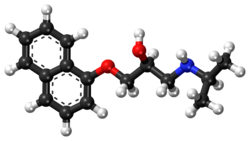Propranolol
 |
|
 |
|
| Clinical data | |
|---|---|
| Trade names | Inderal |
| AHFS/Drugs.com | Monograph |
| License data |
|
| Pregnancy category |
|
| Routes of administration |
By mouth, rectal, IV |
| ATC code | |
| Legal status | |
| Legal status | |
| Pharmacokinetic data | |
| Bioavailability | 26% |
| Metabolism | Liver (extensive) 1A2, 2D6; minor: 2C19, 3A4 |
| Biological half-life | 4–5 hours |
| Excretion | Kidney (<1%) |
| Identifiers | |
|
|
| CAS Number | |
| PubChem CID | |
| IUPHAR/BPS | |
| DrugBank | |
| ChemSpider | |
| UNII | |
| KEGG | |
| ChEBI | |
| ChEMBL | |
| ECHA InfoCard | 100.007.618 |
| Chemical and physical data | |
| Formula | C16H21NO2 |
| Molar mass | 259.34 g/mol |
| 3D model (Jmol) | |
| Chirality | Racemic mixture |
|
|
|
|
Propranolol is a medication of the beta blocker type. It is used to treat high blood pressure, a number of types of irregular heart rate, thyrotoxicosis, capillary hemangiomas, performance anxiety, and essential tremors. It is used to prevent migraine headaches, and to prevent further heart problems in those with angina or previous heart attacks. It can be taken by mouth or by injection into a vein. The formulation that is taken by mouth comes in short acting and long acting versions. Propranolol appears in the blood after 30 minutes and has a maximum effect between 60 and 90 minutes when taken by mouth.
Common side effects include nausea, abdominal pain, and constipation. It should not be used in those with an already slow heart rate and most of those with heart failure. Quickly stopping the medication in those with coronary artery disease may worsen symptoms. It may worsen the symptoms of asthma. Greater care is recommended in those with liver or kidney problems. Propranolol may cause harmful effects in the baby if taken during pregnancy. Its use during breastfeeding is probably safe, but the baby should be monitored for side effects. It is a non-selective beta blocker which works by blocking β-adrenergic receptors.
...
Wikipedia
